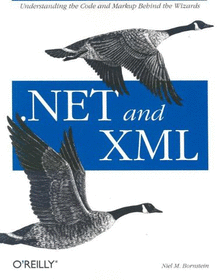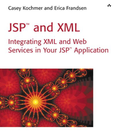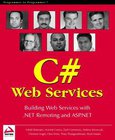.NET and XML

Book Details:
| Publisher: | O'Reilly Media |
| Series: | OReilly |
| Author: | Niel M. Bornstein |
| Edition: | 1 |
| ISBN-10: | 0596003978 |
| ISBN-13: | 9780596003975 |
| Pages: | 400 |
| Published: | Jul 01 2003 |
| Posted: | Nov 19 2014 |
| Language: | English |
| Book format: | CHM |
| Book size: | 1.04 MB |
Book Description:
If you're seeking ways to build network-based applications or XML-based web services, Microsoft provides most of the tools you'll need. XML is integrated into the .NET Framework and Visual Studio .NET, but if you want to get a grasp on how .NET and XML actually work together, that's a different story. With .NET XML, you can get under the hood to see how the .NET Framework implements XML, giving you the skills to write understandable XML-based code that interoperates with code written with other tools, and even other languages..NET XML starts by introducing XML and the .NET Framework, and then teaches you how to read and write XML before moving on to complex methods for manipulating, navigating, transforming, and constraining it. To demonstrate the power of XML in .NET, author Niel Bornstein builds a simple hardware store inventory system throughout the book. As you move from chapter to chapter, you'll absorb increasingly complex information until you have enough knowledge to successfully program your own XML-based applications. This tutorial also contains a quick reference to the API, plus appendices present additional .NET assemblies that you can use to work with XML, and how to work with the .NET XML configuration file format.One study puts the potential market for new software based on XML at or near $100 billion over the next five years. The .NET Framework gives you a way to become a part of it. But to use XML and .NET effectively, you need to understand how these two technologies work together. This book gives you the insight to take full advantage of the power the two provide.
Book categories:
Programming , Software , Web Development , Operating Systems , Languages & Tools , .NET , Windows OS , C# , Web Services , XMLDownload Link:
Related Books:
JSP and XML
Integrating XML and Web Services in Your JSP Application
JavaServer Pages technology allows Web developers and designers to rapidly develop and easily maintain information-rich, dynamic Web pages that are platform independent. JavaServer Pages technology uses XML-like tags and "scriptlets" written in the Java programming language to encapsulate the logic that generates the content for the page. This book is geared towards JavaServer Pages developers, bringing them a confident functionality and usage with XML. There are many examples within the book that are usable in other projects. The reader learns to build and expand custom JSP tags, which can realistically be used on any JSP project. Many advanced topics are also covered to maintain the interest of the more accomplished JSP developer....
A Designer's Guide to Adobe InDesign and XML
Harness the Power of XML to Automate your Print and Web Workflows
Is this book for programmers? Written specifically for graphic designers and production artists already comfortable working with Adobe InDesign, this book teaches you how to automate publishing without learning a lot of scary code. XML simplifies the process of moving content in and out of your layouts and can speed up any print or Web assignment. Why should I care about XML? If you're managing data-intensive layout projects, and you want to keep that data consistent, accurate, and up-to-date, then incorporating XML can help. You can also use XML to automate processes like importing text and large numbers of graphics into a layout, or repurposing content from one application to another. Do I need additional plug-ins or special software? You need onl...
Professional C# Web Services
Building .NET Web Services with ASP.NET and .NET Remoting
Web services are perhaps the most important feature of .NET development. They take componentization to a new level by allowing method calls to be made over the Internet or over an intranet using standard protocols such as HTTP and SOAP. This means that the calling application needs to know nothing about the internal implementation of the service - a web service built in C# on the .NET platform will (in theory) be indistinguishable from one built on Linux using Java. The .NET Framework provides two ways to build web services - ASP.NET and .NET Remoting. Unlike most books on web services, this book covers both of these technologies in depth. .NET Remoting web services require a little extra effort to build, but they offer us greater flexibility. They ...
2007 - 2021 © eBooks-IT.org



